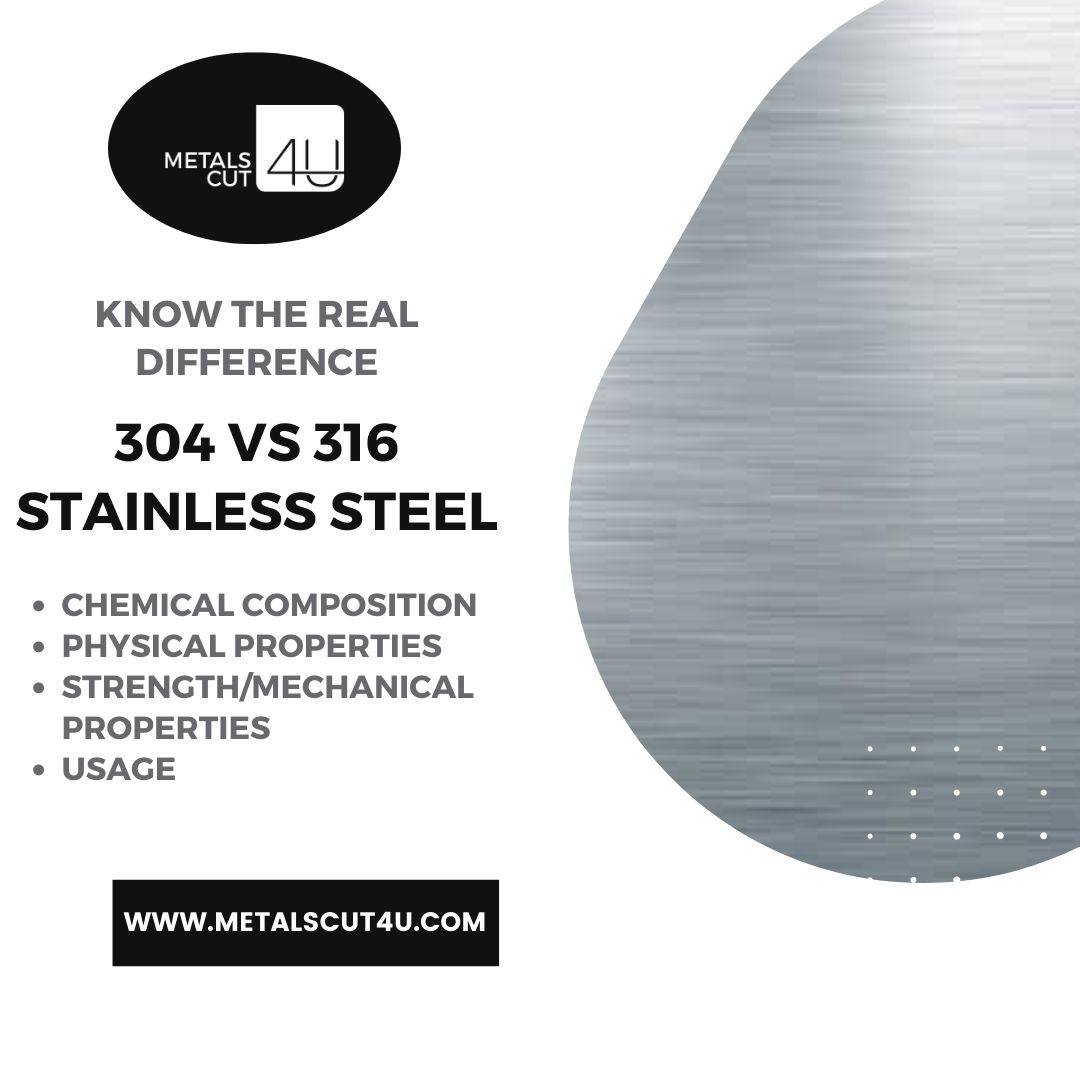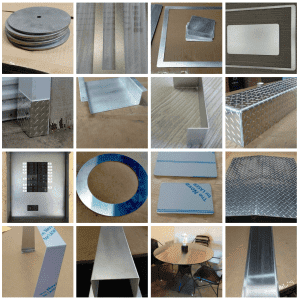304 Vs 316 Stainless Steel: Know The Real Difference

Stainless steel is fabricated using several types of alloy and chemical properties to create a metal that is strongly resistant to corrosion, rust, and moisture and withstands most oxidizing acids. Austenitic stainless steel is one of the high classes of stainless steel that can prevent steel from losing its properties or being hardened by heat treatments. 304 and 316 stainless steel are the two most popular and widely used austenitic steel across the world.
Both 304 and 316 stainless steel are used in wide-ranging industries for various purposes and construction needs. They are known for their strong properties and clear appearances that make them a popular choice among manufacturers. They offer glossy appearances that allow manufacturers to enhance the aesthetics of their finished products without compromising metal durability and rust resistance properties.
Differentiating between the two by looks might be challenging as they have similar appearances. Without any understanding or knowledge about 304 and 316 stainless steel metal, you might face challenges when choosing between the two. However, we can help you expand your knowledge and determine the right choice for your project or personal needs.
Continue reading this post till the end to learn the difference between 304 and 316 stainless steel and vital facts that make them the most popular types of stainless steel.
What is 304 stainless steel?
The austenitic 304 stainless steel type is one of the most popular and commonly used stainless steel in industries. The stainless steel type offers excellent and advanced corrosion and rust-resistant properties. 304 stainless steel contains about 16 to 24 percent of chromium, up to 35 percent of nickel, and small amounts of other elements such as carbon and manganese. This type of austenitic stainless steel is easy to sanitize and cast into desired shapes and sizes.
It is important to understand that there are different categories or variants of 304 stainless steel. Certainly, 18/8 304 stainless steel is the most popular among all. It contains about 18 percent of chromium and 8 percent of nickel properties. Which type of 304 stainless steel to choose mainly depends on the purpose of the project or the metal equipment you want for your personal needs.
You can contact us at 440-822-6381 to know which type of 304 stainless steel is best for your business project and other personal needs.
What is 316 stainless steel?
316 stainless steel type holds the second position in popularity after 304 stainless steel. 316 stainless steel has nearly the same physical and mechanical properties as 304 stainless steel. Therefore, it becomes extremely challenging to differentiate between the two without any prior knowledge or expert help. The key difference between 304 and 316 stainless steel is that 316 steel incorporates about two or three percent of molybdenum minerals.
Molybdenum allows 316 stainless steel types to offer advanced corrosion protection or resistance against chlorides and other industrial solvents. This type of austenitic stainless steel is commonly used in industrial applications used in processing chemicals and high saline environments. Making is an ideal metal type for the marine and medical industry. Medical surgical instruments are often exposed to moisture and chemical compounds that can severely harm the instrument and affect its core areas.
Other types of 316 stainless steel grade offer better chloride resistance than other available options in the market. If you are looking for metals that can easily resist moisture and corrosion from chemical compounds, the 300 series stainless steel type is all you need.
What is the difference between 304 and 316 stainless steel?
Besides offering corrosion and rust resistance, both 304 and 316 stainless steel types serves different purposes and needs. From making to usage, 304 and 316 stainless steel have some major differences. Here are some prime differences between 304 and 316 stainless steel to help you determine the best choice.
1. 304 Vs 316 stainless steel: Chemical composition
The 304 stainless steel grade contains 0.08% carbon, 2% manganese, 0.75% silicon, 0.045% phosphorus, 0.03% sulfur, 18.0/20.0% chromium, 8.0/10.6 % nickel, and 0.1 % nitrogen. The chemical composition might differ depending on the type 304 stainless steel grade.
Whereas, 316 stainless steel grade contains 16% chromium, 10% nickel, 2% molybdenum, and similar chemical composition as 304 stainless steel grade.
Therefore, in the chemical composition of stainless steel 316 Vs 304, there are not many differences.
2. 304 Vs 316 stainless steel: Physical properties
304 stainless steel has a melting point of 1430 degrees Celius, a density of 8.00 g/cm^3, thermal expansion of 17.2x10 ^-6/K, modulus of elasticity of 193 GPa, and thermal conductivity of 16.2 W/m. K.
On the other hand, 316 stainless steel has a melting of 1400 degrees Celius, a density of 8.00 g/cm^3, thermal expansion of 15.9 x 10^-6/K, and thermal conductivity of 16.3 W/m.K.
In the physical properties of stainless steel 316 Vs 304, we notice slight differences in the two.
3. 304 Vs 316 stainless steel: Strength / Mechanical properties
304 stainless steel has tensile strength between 500-700 MPa, elongation A50 mm of 45 Min%, and hardness (Brinell) of 215 max HB.
316 stainless steel has tensile strength between 400-620 MPa, elongation A50 mm of 45 Min%, and hardness (Brinell) of 149 max HB.
Besides elongation A50, in 304 Vs 316 stainless strength/ mechanical properties, there are some significant differences between the two.
4. 304 Vs 316 stainless steel: Usage
304 stainless steel is widely used for applications for
-
Food preparation such as fryers, pans, prep tables, and more without hardening or ruining metal properties.
-
Kitchen equipment, including cookware, silverware, and more to offer better hygiene and cooking experience
-
Architectural application mainly siding, elevators, and bathroom stalls.
-
304 stainless steel grade can also be used in the manufacturing of medical instruments such as trays, surgical tools, and other complex instruments
316 stainless steel is popularly used for the following applications
-
Water handing equipment such as boiler, home water heater, and other equipment through which hot water passes through.
-
Application of marine environment, including boat rails, wire rope, boat ladders, and equipment exposed to moisture.
-
Complex medical equipment and devices.
-
Medical and chemical processing and storage equipment.
We hope, with this 304 stainless steel Vs 316 comparison, you now have a better understanding of these two metals.
Buy 304 Or 316 Stainless Steel
304 stainless steel vs 316: What Makes Them So Popular?
Both 304 and 316 stainless steel are popular for their high durability, strong resistance properties, and flexibility. You can easily create complex medical and chemical instruments without compromising the appearance and properties of the metal.
When it comes to 304 Vs 316 stainless strength comparison, you can see the difference between the two in the above-mentioned pointer.
The price difference between 316 and 304 stainless steel
316 stainless steel can cost you slightly more than the 304 stainless steel grade due increase in chemical compositions. The price structure of stainless steel grade majorly depends on the chemical components involved in making the stainless steel grade. To learn more about 316 Vs 304 stainless steel, you can get in touch with one of our representatives.
304 Vs 316 Stainless Steel FAQ
1. Is 304 stainless steel considered food grade?
Yes, 304 stainless steel is an excellent food process equipment widely used for preparing commercial food products. It contains a high amount of chromium composition, making it more resistant to acidic food and solution.
2. Is 316 stainless steel magnetic?
316 stainless steel comes under a high nickel composition range that is considered as the most non-magnetic stainless steel.
3. What is the 304 stainless steel yield strength?
304 stainless steel has a yield strength of 205 MPa and tensile strength of 515 MPa.
4. What is the difference between steel and stainless steel?
Ordinary steel is steel that does not contain chromium and is susceptible to rust. Stainless steel contains chromium of about 10% or more by weight. Stainless steel is highly resistant to rust and corrosion.
5. Does 304 stainless steel rust?
304 stainless steel is excellent rust and corrosion-resistant metal that can withstand most oxidizing acids. It is an ideal metal option for kitchen use and other food applications.
6. Is stainless steel expensive?
Compared to ordinary or carbon steel, stainless steel is generally more expensive. Several varieties of alloying elements are used to make stainless steel, spiking the overall cost of stainless steel products.
7. How to identify stainless steel?
With the help of some chemical tests, one can easily identify the steel type and which category it falls in. You can get in touch with one of our representatives today to discover an ideal metal option for your needs and purposes or learn more about 316 Vs 304 stainless steel differences from one of our professionals.
At MetalCut4U, we offer high-quality metals at affordable and reasonable prices. Explore our website to find an ideal metal option for your home or business purposes.
